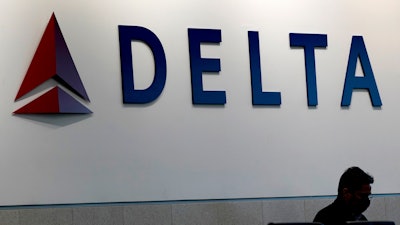
Two Delta Air Lines regional jets collided on the taxiway at LaGuardia Airport in New York, injuring a flight attendant, damaging a cockpit and tearing off part of a wing in what the airline described as a "low-speed collision."
An aircraft carrying 32 people was preparing for takeoff Wednesday night to Roanoke, Virginia, when its wing made contact with the fuselage of an aircraft arriving from Charlotte, North Carolina, with 61 people aboard, according to a statement from Delta.
It wasn't immediately clear who was at fault, but air traffic control had instructed the Virginia-bound plane "to hold short and yield to the other aircraft" before the collision, the Federal Aviation Administration said in a statement.
A flight attendant was taken to a hospital, according to a statement from the Port Authority of New York and New Jersey. One of the pilots told the tower that the flight attendant told him she hit her knee when the planes collided, according to audio that www.LiveATC.net posted. There were no reports of passengers injured, the airline said.
"Their right wing clipped our nose and the cockpit. We have damage to our windscreen and ... some of our screens in here," a pilot said, according to the air traffic control audio.
Images of the damage showed the broken wing on one plane while the other plane's cockpit window was shattered and its nose was deeply gouged in several places.
The plane that had landed "stopped, jerked, and jumped to the right," passenger William Lusk told ABC. "Everyone went dead silent. And as everyone went dead silent, the pilot calmly came on and said, 'Hey, we've been in a crash, everyone remain calm.'"
Close calls like this could add to worries about aviation safety in the wake of recent crashes and near misses including the deadliest plane crash in the United States in decades, when an Army helicopter collided with an airliner preparing to land at Ronald Reagan Washington National Airport.
Former NTSB and FAA crash investigator Jeff Guzzetti said that the ground controller lines up planes on taxiways and directs them where to go, but the pilots are expected to avoid other planes as they move at slow speeds while controllers focus on keeping the runways clear.
"You're supposed to have situational awareness about where your wings are poking out at and what they could hit as you're taxiing," said Guzzetti, who is now an aviation safety consultant. "They (controllers) expect the flight crews to see each other since they're taxiing at a slow speed. And the controller's main function is to make sure the runway is clear for takeoff and landings."
Because this happened at night and planes typically turn off their nose lights while taxiing, it may have been more difficult for the pilots to see exactly where the other plane was, Guzzetti said. A plane's taxi lights are on the wings. The landing lights are used to improve visibility and help make sure other pilots can see the plane, but the FAA encourages pilots to be careful not to blind other pilots because landing lights can also impair night vision.
"Delta will work with all relevant authorities to review what occurred as safety of our customers and people comes before all else," the statement from Delta said. "We apologize to our customers for the experience."
The Delta Connection aircraft involved in the collision were operated by Endeavor Air. Both are CRJ-900 planes, said the FAA, which is investigating. The planes can seat 70 to 90 passengers.
LaGuardia Airport is one of 35 major airports where the FAA has installed advanced surface radar systems that help track aircraft and vehicles on the ground and alert controllers to potential conflicts. It wasn't clear what role the system played in this collision.
Guzzetti said he's not sure if that system would have sounded an audible alarm for these planes on a taxiway even though the system would have shown both planes on a display. The primary purpose of the system is to prevent collisions on runways.
The passengers on both planes were provided meals and hotel rooms and rebooked on flights leaving on Thursday.
___
Associated Press writer Kathy McCormack in Concord, New Hampshire, Hallie Golden in Seattle and Sarah Brumfield in Cockeysville, Maryland, contributed to this story.






















